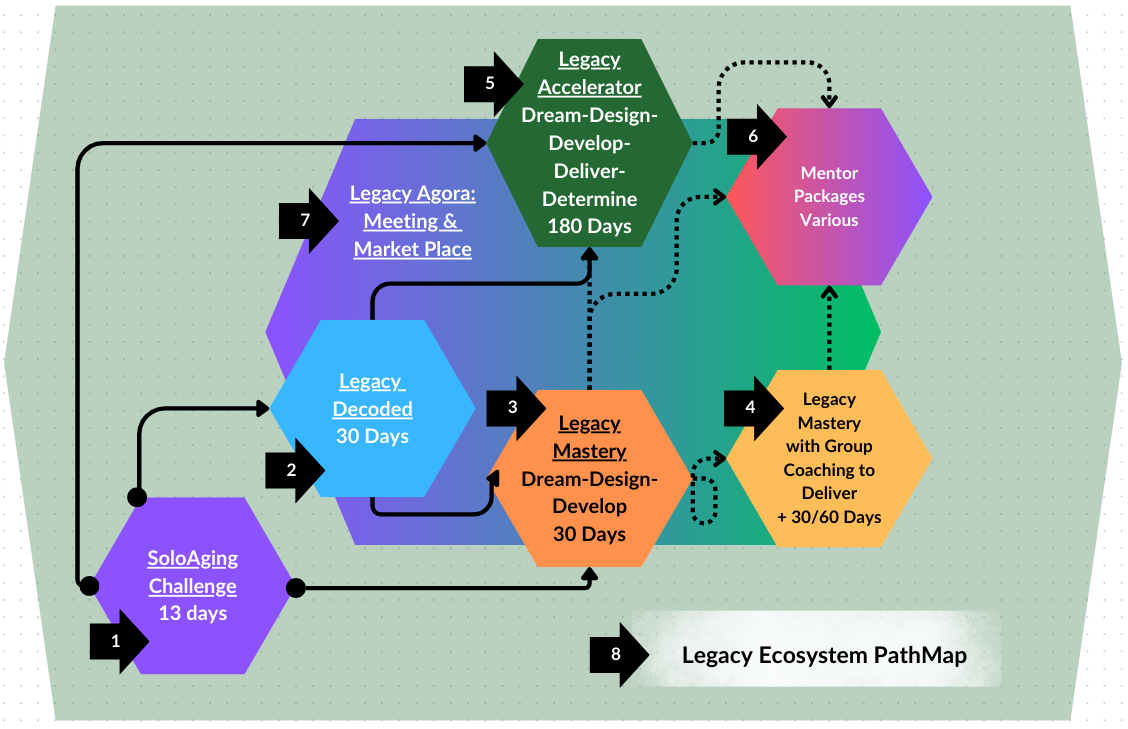In this article, we consider the connection and convergence between these two practices, unraveling their interplay and how they combine to acknowledge, advance, and amplify our words.
As you move through the article more emphasis is placed on an awareness writing approach and practices. Consider this blog post as an introduction, knowing more insights will follow in other posts. There is a course in development with support resources like a book, prompt workbook, and journal.
Transparency: From the rumblings of Dr. Stephen Hobbs, Founder WELLth Movement
Walking In:
At the heart of living your great - remarkable - memorable - extraordinary life
lies your request for a profound valuing of
_your inner self in being for the world
- like a portrait painting - conscious writing - inside out (within-without)
_your outer presence in being with the planet
- like a landscape painting - awareness writing - outside in (without-within)
What is the connection, competition, and collaboration between conscious writing and awareness writing
Conscious writing and awareness writing are related practices that share common outcomes but differ in their approaches.
They coexist, compete, and/or collaborate, depending your writing objectives//outcomes and the context in which they are used:
- Connection:
- Shared Goals: Both conscious writing and awareness writing aim to explore one's thoughts, emotions, and experiences, leading to self-discovery, personal growth, and self-expression. They foster a deeper understanding of living life.
- Mindfulness: Both practices encourage mindfulness and being present in the moment. They promote reflection-in and reflection-on, and help persons connect with their authentic selves.
- Catharsis: Both can serve as ways to process (and deal with) hindering emotions, experiences, and challenges, providing a sense of release and relief.
- Competition:
- Limited Time: If you have limited time for introspective practices, conscious writing and awareness writing may compete for your focus, as they both require dedicated time and effort.
- Writing Style: They can compete in terms of writing style and structure. Conscious writing might involve more deliberate, structured, and edited writing, while awareness writing may be more free form and stream-of-consciousness.
- Collaboration:
- Combined Approach: Many individuals find that conscious writing and awareness writing can complement each other. That is, when you allow the formal arrangement and informal connections to flow through your portrait and landscape lenses.
- Enhanced Reflection: Combining the two practices can enhance reflection in, reflection on, and reflection because of. You may begin with awareness writing to free your mind and then transition to conscious writing to delve deeper into specific topics. And vice versa!
- Creative Expression: Conscious writing can add a creative and structured aspect to awareness writing, enabling you to refine and express your insights in a more organized manner.
Another way to consider
the connection, competition, & collaboration
between the writing approaches is:
Conscious Writing is about the background while Awareness Writing is about the foreground.
With Conscious Writing you see a few trees and ask what is between them.
With Awareness Writing you look at the landscape you see the forest with the trees.
Alert: I'm sharing my perspective here...
as a way to help me and possibly guide you
to a similar definition of terms & concepts
to assist your writing.
This foreground consideration invites the awareness of intention and attention. The interconnected aspects of the three play significant roles in shaping our experiences via activities, behaviors, & consequences.
Intention: Intention refers to a person's purpose, goal, or aim to achieve a particular outcome or engage in a specific action. It's the mental state that directs our thoughts and actions toward a desired objective. Intentions can be conscious or subconscious and serve as the driving force behind our decisions and behaviors.
Attention: Attention is the cognitive process of focusing mental resources on specific stimuli or information while filtering out or ignoring other inputs. It involves selecting and concentrating on particular aspects of our internal or external environment. Attention is often directed by our intentions and interests. What we intend to achieve or what we find important guides where we allocate our attention.
Awareness: Awareness encompasses our overall state of presence, including what we are thinking, feeling, and perceiving. It involves being attuned to both our internal mental states and external surroundings. Awareness is a broader and more inclusive concept that weaves together intention and attention.
Here's how these three concepts connect:
Intention guides Attention: Your intentions influence what you choose to pay attention to. For example, if you intend to learn a new skill, your attention will naturally gravitate toward resources and activities related to that skill.
Attention influences Awareness: What you pay attention to shapes your awareness. When you focus your attention on something, you become more aware of it. Conversely, when you ignore something, it tends to fall outside your awareness.
Awareness informs Intention: Being aware of your thoughts & feelings with the environment can inform your intentions. For instance, if you become aware of feeling stressed because of an external factor, you may set an intention to engage in relaxation techniques to address that stress.
Consideration:
These three elements are intertwined and work together in our daily lives (outside in). They are interconnected elements investigating without to reason for navigating within.
This background consideration invites the consciousness of subconsciousness and unconsciousness. Their interconnections shape our presence via activities, behaviors, and consequences.
Consciousness: Consciousness is the state of being awake and alert to one's thoughts, feelings, and sensations. It involves the ability to perceive and process information, make decisions, and experience subjective ideas/insights. Consciousness is often described as a continuous stream of thoughts and experiences that make up an individual's presence.
Subconsciousness: The subconscious, refers to mental processes and information that are not currently in the forefront of consciousness but can be accessed or brought into consciousness. It encompasses thoughts, memories, beliefs, and emotions that may influence a person's behavior, even though they are not actively thinking about them. The subconscious mind plays a significant role in shaping our automatic responses, habits, and many aspects of our psychological makeup.
Unconsciousness: Unconsciousness is a state in which an individual lacks responsiveness, and cognitive function. It can be a temporary condition, such as when a person loses consciousness due to fainting or anesthesia. In a psychological context, the unconscious refers to the part of the mind that contains thoughts, memories, and desires that are not within conscious awareness.
Here's how these three concepts connect:
Consciousness and Subconsciousness: These two states are in constant interaction. Our conscious thoughts and experiences are influenced by subconscious processes. For example, our preferences, fears, and biases can be rooted in the subconscious mind.
Subconsciousness and Unconsciousness: The subconscious mind operates both in our conscious and unconscious states. It contains information and memories that are not immediately available to conscious awareness.
Consciousness and Unconsciousness: While these two states might seem opposed, they are part of the same continuum of living life - presence. Consciousness can be temporarily altered or suspended, leading to unconsciousness during sleep or anesthesia.
Consideration:
These three terms represent different levels of mental processes (inside out). They are interconnected elements interpreting within for reasons of interacting without.
For reasons without-within (outside in)
To reason within-without (inside-out)
Moving Forward
Conscious writing and awareness writing share common objectives but differ in their approaches. They can compete if time and focus are limited, but they can also collaborate effectively to provide a well-rounded self-exploration experience. The choice between their competition and collaboration depends on your personal preferences and the specific goals/outcomes you have for your writing practice.
Transparency: AI-assisted based on priming and prompting! Considerable editing followed.
Along the journey as you weave your tapestry, understanding StoryScope and Legacy are important concepts and practices. A quick reminder of both follow:
Understanding the StoryScope
Our lives are stories waiting to be told, narratives that unfold with each passing day.
The metaphor of "StoryScope" invites us to view this narrative through different lenses. Just as telescopes reveal the vastness of the universe, microscopes uncover the intricacies of the microscopic world, stethoscopes listen to our vital sounds of living, our StoryScope allows us to explore and find the full spectrum of our daily existence.
Our daily lives resemble a kaleidoscope, with each decision, action, and interaction contributing to the ever-shifting, meaningful pattern.
As SoloAgers and seasoned professionals, you have a unique perspective on life's twists and turns. Your legacy is not only a reflection of your past-present but a blueprint for the future-present.
Legacy: The Useful Whats
Legacy is often associated with material wealth, but it extends far beyond possessions. Legacy comprises the "useful whats" we leave behind, including our time, effort, and money. These elements are the building blocks and seedbeds of our legacy, and how we allocate, plant them shapes the stories we share.
For SoloAgers, who have accumulated a wealth-wellth of experiences and knowledge, legacy is about passing on wisdom and lessons. Your is about preserving your story as it is about empowering others to write their chapters more skillfully. As professionals and educators, your legacy resides in the work you shared, the values you instilled, and the innovations you sparked.
Guide to Programming through WELLth Movement
for SoloLiving-SoloAging: Professionals and ParaProfessionals
If you have a Question and/or Comment
about one or more of the Programs and Projects identified
in the Legacy Agora EcoSystem and/or the PathMap,
please use this form. TU!
PS: The System and Maps are subject to Edits.
Transparency: AI-assisted based on priming and prompting! Considerable editing followed.
Please
share - TU!
It's all about sharing the legacy you intend to live (and leave).
For more in-depth insights about:
INVITE Soloaging Olders to be Elders
who discover, shape, and share the legacy
they intend to live and leave Start here
Certification as a mentor Start here
To contact us use our Contact Page
Add your comments - update the insights in your words
- share funnies for all of us to read below the blog list!
June 25, 2025 New Moon Edition of the Solace Grove Magazine 8Where
Saturday Legacy Stories from Solace Grove #7AWhere Mountains Meet Community, and Every
Saturday Legacy Stories from Solace Grove #6AWhere Mountains Meet Community, and Every
Saturday Legacy Stories from Solace Grove #7Where Mountains Meet Community, and Every
Saturday Legacy Stories from Solace Grove #6Where Mountains Meet Community, and Every
Saturday Legacy Stories from Solace Grove #5Where Mountains Meet Community, and Every












